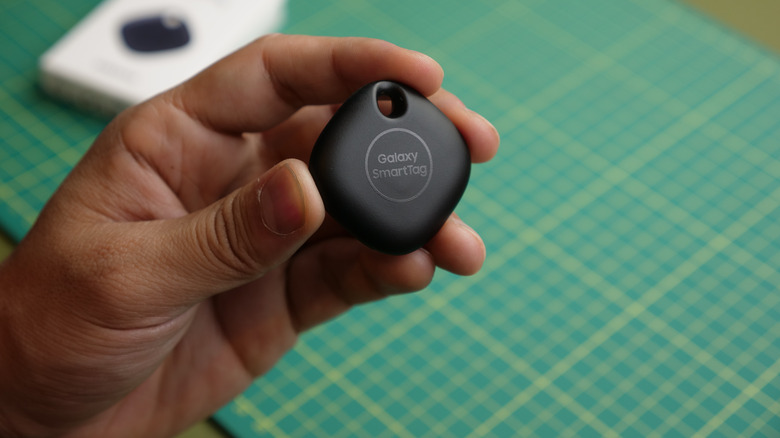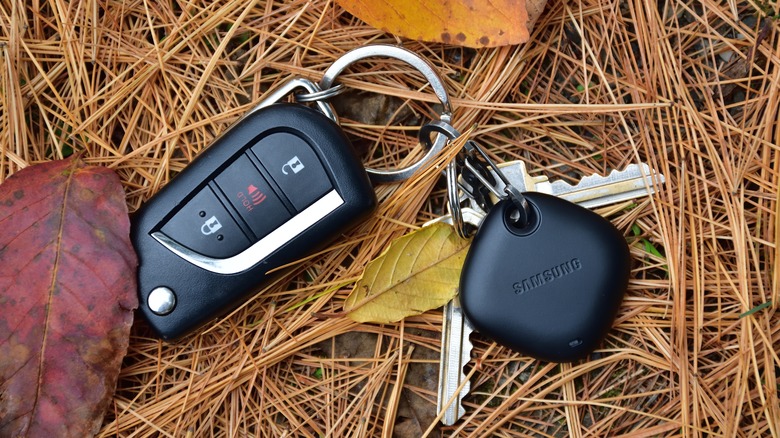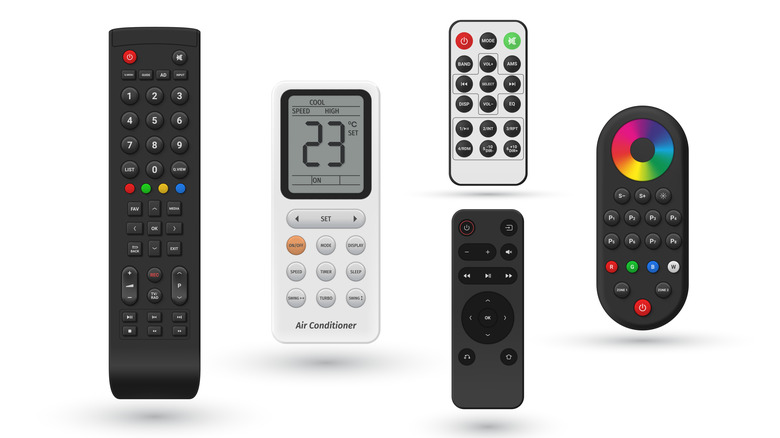5 Smart Ways To Use Samsung Galaxy SmartTags
We may receive a commission on purchases made from links.
In October 2023, Samsung released the newest iteration of its SmartTag tracker device, the SmartTag2, which follows up on the improvements made in the previous SmartTag+ revision by increasing its battery life as well as its resistance to dust and water. Designed primarily to work with Galaxy phones, SmartTags are Samsung's answer to Tile and Apple's AirTag.
"After analyzing thousands of reviews of the previous iterations, we noticed some feedback about minor inconveniences that affect the user experience," said Samsung product planner Dalwon Kim in a press release. "Our goal for this version was to create a design that is smaller, lighter, and attachable anywhere. We also wanted to make sure the battery was not easily removable. We took outdoor activities into account and made specific improvements to enhance the product's durability, such as adding IP67-rated water- and dust-resistant features."
The most common use of SmartTags and its competitors are as trackers, but they offer some other benefits as well, including being able to use the button on the tag to start an automation sequence, like sending a pre-written text message to a specific person or operating a smart appliance made by Samsung or a partner compatible with SmartThings. With that in mind, let's look at some of the best use cases for Samsung's SmartTags.
SmartTag vs. SmartTag+ vs. SmartTag2
Before getting into the suggested uses of your SmartTags, we need to stress that, to date, there have been three different versions of Samsung's tracker: The original SmartTag, the SmartTag+ that added ultra-wideband connectivity, and the SmartTag2.
The original SmartTag had exactly one type of wireless connectivity protocol built-in, Bluetooth Low Energy 5.0, and had a range of 120 meters. It also came in two colors, black and "oatmeal," and included two finding tools: A map on your phone or computer and the ability to ring the SmartTag. The SmartTag+, meanwhile, was mostly the same, with three exceptions. That revision made the SmartTag slightly bigger (46mm square instead of 39mm square), swapped in a "denim blue" option for "oatmeal," and, most importantly, SmartTag+ added ultra-wideband (or UWB) connectivity, which allowed for more precise location information and the ability to use an augmented reality device finder on your phone.
The SmartTag2, though, is a significant revision. Battery life has been improved by what Samsung claims to be 50%, to "up to 500 days," while a new power-saving mode increases that term to "up to 700 days." Its water and dust resistance rating was upped from IP53 to IP67, the UWB connectivity from the plus model was included, and you can also embed a message in a SmartTag2 that can be read over NFC. To use the obvious example, you can include contact information you're comfortable giving out so your item can potentially be returned to you.
Putting a SmartTag on your keyring
One use of SmartTags is so obvious that Samsung had it in mind when designing the tags: Using the hole punched in the tags to put one on a key ring so you can easily find lost keys. Samsung itself singled out the SmartTags serving as key finders, highlighting the example use case of someone getting ready to go to work, realizing they couldn't find their keys, and using the SmartThings app to help them locate their keys under couch cushions by telling the app to ring the SmartTag.
Putting your SmartTag on a keyring is, unsurprisingly, a common use case cited in professional reviews of the trackers. "Up close, the SmartTags allowed me to find all manner of things in my cluttered home," reads part of Laptop Magazine's review of the original SmartTag. "I found my keys several times after wracking my brain for where I last saw them." The same review also gives a more specific example, where the SmartTag "helped me find my misplaced keys in the dirty clothes hamper in the pocket of yesterday's pants, just in time to avoid a date with the washing machine."
On a pet's collar
The loop on the SmartTag2 that makes it easy to attach to a keyring also makes it a great fit for the collar of a dog, cat, or other similarly-sized household pet. "When he hears the doorbell, your dog Buddy races to the door," reads the relevant copy in the aforementioned early SmartTags press release. "As nice as it is that he greets visitors, he sometimes gets out while you're receiving a delivery. Once again, Buddy escapes the moment you open the door and runs off down the street. Fortunately, you've attached a SmartTag to Buddy's collar."
Having said that, if you can budget more than the price of a SmartTag for tracking your pet, you should absolutely do so, as GPS-based options are available. Tractive is probably the most affordably priced option at $49.99 retail, but it's sometimes on sale — including during holiday sales — for $29.99, just a few dollars more than a SmartTag.
If you have a large, sprawling, fenced-in property and just need to be able to more easily corral your pet within that secure area, then a SmartTag is probably fine in that use case. (Note how the Samsung press release is specific that "Buddy" only ran down the block.) If you want to be able to track a potentially lost pet beyond the length of a football field, then a GPS tracker is the way to go.
As a quick-access portable controller for appliances
Though not promoted nearly as heavily as its primary use as a tracking device, there's something else that you can use your SmartTag for. You can program its button to control smart appliances via the Samsung SmartThings app. There, different functions can be assigned to pressing and holding the button.
"You're heading out and have already gotten to your car when you remember that you forgot to turn off the air purifier in the house," reads an early Samsung press release that laid out various examples of SmartTag uses. If a smart appliance from Samsung or a partner company can be added to the SmartThings app, then you can use a SmartTag to control it in a limited capacity. You can assign one function to pressing a button on the SmartTag and another to holding the button down.
With Samsung being among the smart appliance manufacturers working as part of the Home Connectivity Alliance to make it so that different brands' smart devices and apps can work together, this feature promises to become more useful as time goes on. Alternatively, you can program the SmartTag to send a pre-written text message to a specific, preordained contact using the same button press or hold.
Attach it to a remote control
Besides keys, there are probably few objects more closely associated with being easily misplaced than remote controls. Though this problem is most closely associated with TV remotes, it can just as easily apply to the remote for an air conditioner, audio/video receiver, or Blu-Ray player, among other things.
Some remotes are more replaceable than others in terms of whether or not they can easily be replaced by universal remotes, have all of their functions duplicated with buttons on the device being controlled, or are best replaced by an exact duplicate, but exact replacements can sometimes be expensive or hard to find.
If the functionality isn't duplicated on the device and the device is something you can't go long without having control over, like HVAC units, then that's another reason to tag a remote so you can find it promptly. So, if there's a remote that you have particular concerns about losing, then you should consider affixing a SmartTag to one.
The best way to do this would probably be to affix the SmartTag to the back of the remote using mounting tape or a small mounting square. If there's a remote that you can't afford to lose, then the cost of a SmartTag is probably worth spending for the peace of mind.
Pill boxes/bottles and other medication containers
If you take any medications that you rely on day to day, then you know how frustrating it can be to misplace a pill box broken down into your daily dosage, much less a whole pill bottle. Missing a dose is bad enough, but a lot of people have daily medications that are not easily replaced, even if they have responsive, attentive doctors whom they know they can rely on for a new prescription in a pinch. If you were to lose a full month's supply of a controlled substance, like narcotic/opioid painkillers or testosterone replacement therapy, your doctor writing a new prescription and your pharmacist filling it is a lot easier said than done. And that's to say nothing of any potential cost/insurance claim issues.
So if you're particularly worried about losing medication in some form, like losing a pill box while out of the house or even knocking a pill bottle off of a nightstand into the abyss that exists underneath and behind pieces of furniture, why not consider affixing a SmartTag to whatever pill receptacle it is that you're worried about losing? You could even put all your medications into a larger bin or box outfitted with a SmartTag. But if your concern is a single bottle falling and vanishing under your bed, it's probably best to put the tracker on a dedicated bottle for that prescription.






